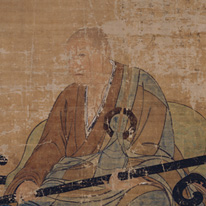Past Exhibitions
- Chinsō: Portraits of Zen Priests
- August 11, 2015 - September 13, 2015
Portraits of Zen priests are called chinsō (literally "countenance of the peak") in Japanese. This term refers to the view of the crown of a buddha's head, a lofty place that can never be seen. When used in the context of painted or sculptural portraiture, the term chinsō expresses sublime reverence for the master.
Zen portraits were used for many purposes, but their primary function was to certify the transmission of religious lineages. Agreeing to write an inscription on a portrait brought to him by his disciple meant that a Zen master was formally choosing the disciple as his successor. As with Buddhist robes and some kinds of Zen calligraphy, authenticated portraits were symbols of dharma transmission.
This unique Zen method of certification originated in Southern Song dynasty China and was brought to Japan by Chinese Chan (Zen) priests and by Japanese priests who had studied in Song. It took root in Japan during the Kamakura period, in the late 1200s.












